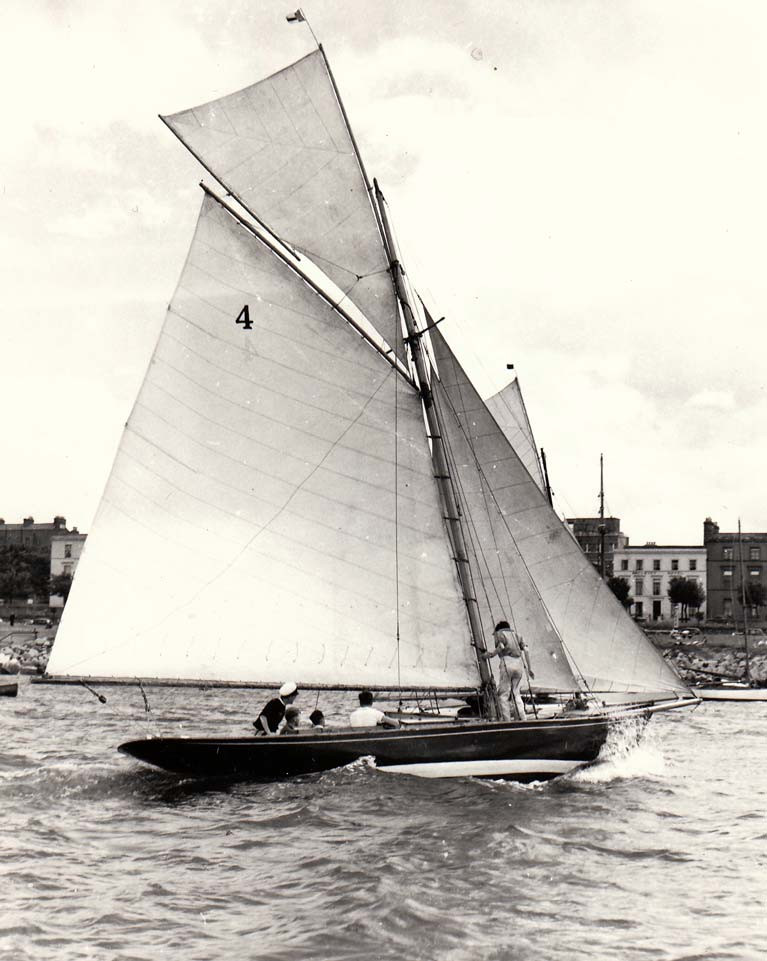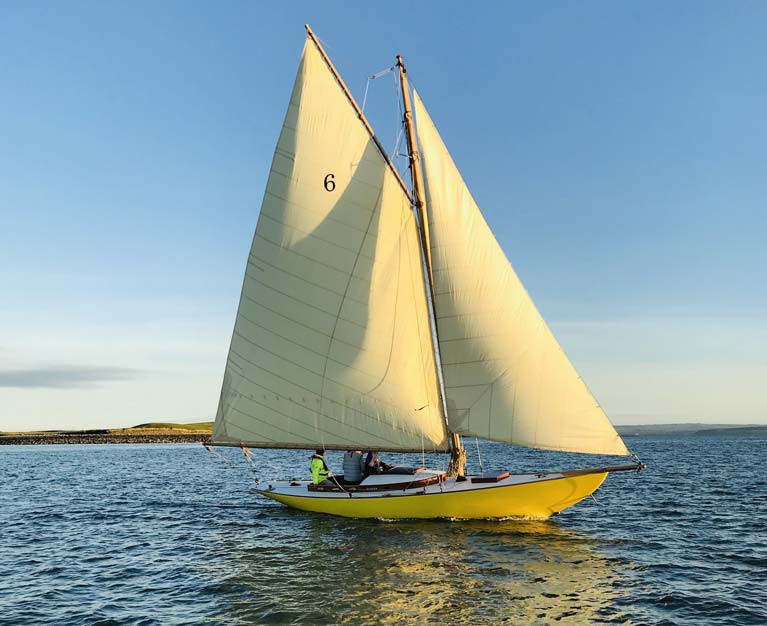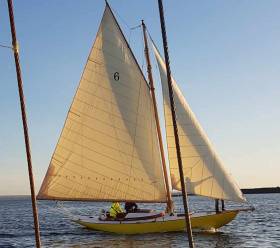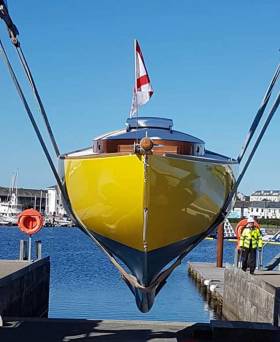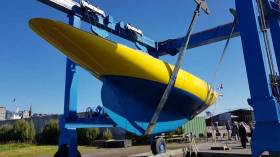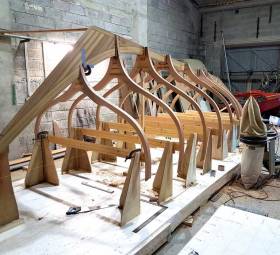Displaying items by tag: Dublin Bay 21
Water Wags, Dublin Bay 21s & Howth 17s: Classic Irish Boatbuilding is Pandemic Panacea
In times of stress like this, there is nowhere more soothing than a well-organised but not unduly fussy timber workshop where each day's harmonious effort shows a tangible result. And of all such workshops, there's nowhere so healthily absorbing – both mentally and physically - than a place where they build wooden boats. For not only is something of beauty being created in time-honoured style in a material for which we feel an instinctive affinity, but at the end of it all you have a work of practical art in which it is possible to sail away, and for a little while at least, escape the tedious everyday concerns of shore life.
That said, it is a fact that in Ireland the best of our classic classes continue to thrive, and have new boats built, not only because the owners are enthusiastic appreciators of ancient style, but because the boats provide excellent one-design racing. The importance of good and demonstrably fair sport should never be under-estimated, and thus at various stages of the building, the normal mood of calm creation is interrupted by the scheduled visit of the class measurer.
Happily, things are now at such a steady throughput of production that the Visit Of The Measurer is a social occasion of ceremony and well-formatted routine rather than a nightmare, as the secret is to have the measurer involved from a very early stage, which is easily achieved in a country the size of Ireland.
 Just inhale gently but steadily – the sweet interior of a new-built classic wooden hull at its best with Shindilla in Athlone. Photo: Cathy Mac Aleavey
Just inhale gently but steadily – the sweet interior of a new-built classic wooden hull at its best with Shindilla in Athlone. Photo: Cathy Mac Aleavey
Thus there are several timber boatbuilding or restoration projects underway at the moment, and while there are some we'll be looking at in due course, today it is intriguing to draw comparisons between jobs under way in Athlone, Howth and Kilrush.
Along the Shannon above Athlone, we recently lost one of Ireland's greatest-ever boatbuilders with the death at the age of 94 of Jimmy Furey of Mount Plunkett near Leecarrow in Roscommon. Busy to the end, in his later days he worked with several boatbuilding development projects with former Olympic sailor and round Ireland record-holder Cathy Mac Aleavey, together with another of those seemingly born-to-it boatbuilders who emerge in the Athlone region, Dougal McMahon.
Working with Jimmy, a project had been coming along to build a replacement for the well-worn Dublin Bay Water Wag Shindilla, a 1932 veteran originally built for Ninian Falkiner who was later a noted offshore cruiser and Commodore of the Royal Irish YC, while Shindilla stayed within the extended family as his daughter married into the Collen family, and it is the Collens who have ensured that Shindilla lives anew. The work has been completed in a shed provided by Dougal's father in Athlone, who may have been an engineering bridge-builder by profession, but he's no slouch at the wooden boatbuilding himself.
 The 1963 Tyrrell-built Harklow is Dougal McMahon's current restoration project
The 1963 Tyrrell-built Harklow is Dougal McMahon's current restoration project
With Shindilla completed, Dougal, is spending the rest of the winter on a restoration job in a bigger shed in Portumna on the classic Shannon cruiser Harklow, originally built by Jack Tyrrell of Arklow for sailing legend Douglas Heard (he won the first Helmsman's Championship in 1946) and now owned by Half Ton Racing ace Johnny Swann.
HOWTH 17 BUILDING
Johnny grew up in Howth, and just round the corner from his family home, recently-retired airline captain Gerry Comerford is building what looks like being the strongest Howth 17 ever constructed, the completely new Anna, which is named for his mother. With laminated backbone and frames, and king-size stainless steel floors make up by a steel-working genius in Clontarf, you might well be concerned that Anna will come out over-weight, but this doesn't seem to be a bother among Howth 17 folk.
 The latest Howth 17 Anna is currently under construction by owner Gerry Comerford at his home in Howth
The latest Howth 17 Anna is currently under construction by owner Gerry Comerford at his home in Howth
For they well remember that many years ago when all the local cruisers had to be weighed to comply with Channel Handicap Measurement requirements, the Howth 17s got hold of the load cell for a day or two to weigh their own boats at launching time. They found that despite the mostly very old boats being only 22ft 6ns LOA (they go back to 1898), there was a half-ton range in their measured weights. Yet, to everyone's surprise, it was the class's most renowned light airs flyer which was the heaviest boat of all…
 Singing from the same hymn sheet – Howth 17 measurer Rupert Jeffares with new owner-builder Gerry Comerford and Anna. Photo: Ian Malcolm
Singing from the same hymn sheet – Howth 17 measurer Rupert Jeffares with new owner-builder Gerry Comerford and Anna. Photo: Ian Malcolm
Regardless of weight, Anna will certainly have the correct dimensions, as class measurer Ruper Jeffares – for many years the Executive Secretary of Howth Yacht Club – lives close, just down the hill, and dropping by Gerry's house to see how Anna is coming along is always of interest, for in their long existence, only two other Howth 17s have ever actually been built in Howth, and that was way back in 1988.
 At an early stage, it was abundantly evident that Anna was going to be built extra-strong. Photo: Ian Malcolm
At an early stage, it was abundantly evident that Anna was going to be built extra-strong. Photo: Ian Malcolm
Thus although the building of Anna has been going on for four years, now that Gerry has retired from the day job he'd better get a move on. For as soon as the lockdown eases, current Howth 17 National Champion Shane O'Doherty (he won it in August with the 1900-vintage Pauline) will resume his popular guided Hill of Howth Hiking Tours, and "Traditional Boat-building with Gerry and Anna" could easily become a must-see stopover on the way over the hill, but a formidable distraction from Work in Progress….
DUBLIN BAY 21s BORN AGAIN IN KILRUSH
Meanwhile, across country in Kilrush on the Shannon Estuary, Steve Morris and his team - having launched the newly-built electrified Galway Bay gleoiteog Naomh Fanchea last week – have now returned to full focus on the latest pair of re-born Dublin Bay 21s, Maureen and Estelle, for the DB21 project by Hal Sisk and Fionan de Barra.
With boatbuilders of the enormous experience of Steve himself, together with Dan Mill and James Madigan (who is of Kilrush, but was much involved with the Ilen project in Limerick) the actual building has an educational element, and apprentice Kate Griffiths was working and learning today (Tuesday) with Dan on Maureen, battening off the new hull prior to laminating the light timbers (two per bay) between the main frames, while nearby James was fairing out Estelle's new deck, which is of laminated Douglas fir beams and carlins.
 The 1903 Dublin Bay 21 Maureen continues to re-emerge in Kilrush with apprentice boatbuilder Kate Griffiths (behind boat) and master shipwright Dan Mill. Photo: Steve Morris
The 1903 Dublin Bay 21 Maureen continues to re-emerge in Kilrush with apprentice boatbuilder Kate Griffiths (behind boat) and master shipwright Dan Mill. Photo: Steve Morris
For sure, there are modern epoxies and other chemicals involved in this form of boatbuilding, just as there is with Anna across in Howth and also – though to a very much lesser extent - with Shindilla in Athlone. But nevertheless, in all cases, the abiding impression of the dominant material in use is wood, glorious wood.
 James Madigan at work n the new deck on the DB21 Estelle. Photo: Steve Morris
James Madigan at work n the new deck on the DB21 Estelle. Photo: Steve Morris
Dublin Bay 21 Sisters Reunited Afloat for First Time in 34 years
The dedicated and detailed process whereby Hal Sisk and Fionan de Barra are restoring the historic Dublin Bay 21 Class (founded 1903) for a meaningful role in the 21st century has taken a major step forward with the 1903 Portrush-built Garavoge, and the only Dun Laoghaire-built boat - the 1905 Naneen - now both afloat with Steve Morris and his skilled boat-building team at Kilrush Boatyard.
The timeless beauty of the highly-regarded Alfred Mylne design lives again, and though current circumstances have inevitably delayed the painstaking project of bringing the class back to life, the work goes on.
Dublin Bay 21’s Black Beauty Shines Again in Kilrush
The complex project of restoring the Alfred Mylne-designed Dublin Bay 21 class – which first raced in 1903 and ceased racing in 1986 – has been in hiatus during the Lockdown. But now Hal Sisk and Fionan de Barra have the good news that work has resumed on their Grand Design, with Steve Morris in Kilrush Boatyard moving the 1903-built Garavogue into the painting stage.
The first completed restoration was on Naneen – number 6 - apparently because, although not built until 1905, she was the only one actually constructed in Dun Laoghaire, the builder being James Clancy. The relatively small yacht-building industry of Kingstown - as it then was - had been too busy with adding boats to the Dublin Bay 25 Class to find the space or time for the first five of the new DB21s, of which three were initially built by Hollwey in Ringsend in Dublin, while James Kelly in Portrush on the north coast built two.
 Portrush 1903, and proud owner W R Richardson has travelled by train from Dublin with many friends for the launching of his new DB21 Garavogue by boatbuilder James Kelly. Photo courtesy Robin Ruddock
Portrush 1903, and proud owner W R Richardson has travelled by train from Dublin with many friends for the launching of his new DB21 Garavogue by boatbuilder James Kelly. Photo courtesy Robin Ruddock
Naneen emerged from Dun Laoghaire in 1905, while the final boat in the Dublin Bay group - Geraldine No 7 – was another one from Hollwey, this time in 1908. Whatever about their year of origin, they all looked equally sad lying together in storage in a farmyard in County Wicklow for three decades, so when the miraculous revival finally began, there was a certain logic to start with the most quintessentially Dun Laoghaire boat of all.
It was a major breakthrough when, down at Kilrush, the beautifully re-built Naneen went afloat in September 2019 for the first time since 1986. And it was even more special when some freakishly good weather in early December enabled her to take her first sunlit sail in the Shannon Estuary.
 The re-built Naneen has her first sail in 33 years in the special sunshine of early December on the Shannon Estuary
The re-built Naneen has her first sail in 33 years in the special sunshine of early December on the Shannon Estuary
The thinking behind it all is that they’re reviving a class every bit as much as much as they’re re-building individual boats, which means that some aspects of the original design – not least the labour-intensive gaff cutter rigs - have been modified to make the DB21s of 2020 more user-friendly, with reduced maintenance demands. But with a class of only seven boats, one of the features of the DB21s in their original form was that every boat was able to have a different and distinctive colour, and this is being repeated in the re-born flotilla.
With Naneen it was a case of replicating a particular shade of yellow with a hint of green, and it looked a perfect finish as she sailed along inside Scattery Island in December. But with Garavogue No 4 - perhaps the most renowned of all the DB21s through her association with the family of Patrick Campbell the writer – the real challenge has come, as she was always black, which would be the most unforgiving colour of all in revealing any blemishes in the hull of what is still essentially a hand-built boat, albeit with a multi-skin epoxy resinated hull.
 Even with finishing trim still required, the classic quality of Garavogue glows through her newly-applied topside finish. Photo: Steve Morris
Even with finishing trim still required, the classic quality of Garavogue glows through her newly-applied topside finish. Photo: Steve Morris
So it says much for the Steve Morris approach that, in resuming work in Kilrush, instead of taking on an easy task to get thing moving again, he went straight head-on into the challenge of giving Garavoge three coats of flawless black enamel. They say that striving for perfection is the enemy of the good, but if that’s the case, then this is very, very good unto what looks rather like perfection.
 If this isn’t perfection then it’s something very like it. Photo: Steve Morris
If this isn’t perfection then it’s something very like it. Photo: Steve Morris
It is hoped that Naneen and Garavogue will both be sailing off Kilrush in July, and then their second debut in Dublin Bay will be in August, while work will be progressing back in Kilrush on Estelle (No 3) and Oola (No 5), with the prospect of four re-built boats forming the nucleus of the re-born class in Dublin Bay in 2021.
Dublin Bay 21 Celebrity Sailor Warns of Dangers of Sneezing
With hopes being expressed that we’re approaching peak COVID-19, there’s concern that people will relax their vigilance in maintaining the proven quarantine precautions, and that numbers will start to rise again. One of the most frighteningly effective ways of spreading the infection is through sneezing, and the US Navy – whose ships are potentially lethal Coronavirus-spreading incubation units – has made comprehensive laboratory tests.
These tests have demonstrated that a violent sneeze can actually spread the infective droplets by as much as eight metres – four times as far as the recommended two metres Safe Social Distancing that health authorities worldwide are recommending.
However, the technical videos which demonstrate this frightening reality look so much like some Computer Generated footage that they fail to make any real impact on a public already be-numbed with Government Information fact-sheets and films. So at Afloat.ie, we reckon that a graphic description of the effects of a monster sneeze is now more effective in capturing attention, and for the necessarily vivid account, we turn to the writings of a former Dublin Bay 21 sailor.
Patrick Campbell (1913-1980) was the son of Lord Glenavy, a noted Dublin polymath who was a Governor of the Bank of Ireland, a barrister, and an economist of international standing, while his mother Lady Glenavy was the artist Beatrice Elvery of the sports shops family. Their lively family life reflected their many talents, but young Patrick failed to settle into any lasting career, and in the end drifted into journalism, becoming for a while the Quidnunc who wrote the daily Irishman’s Diary in The Irish Times.
This was during the 1940s when life was lived in a more economical style. But having seen one of their houses burnt down by Anti-Treaty forces during the 1920 - an event of which Campbell was to write a brilliant account - the Glenavy family lived well during the 1930s, and while young Patrick was an unexpectedly good golfer (for he was something like 6ft 5ins tall, and awkward with it) he and his father – always simply referred to by the family as “The Lord” – were into several sports.
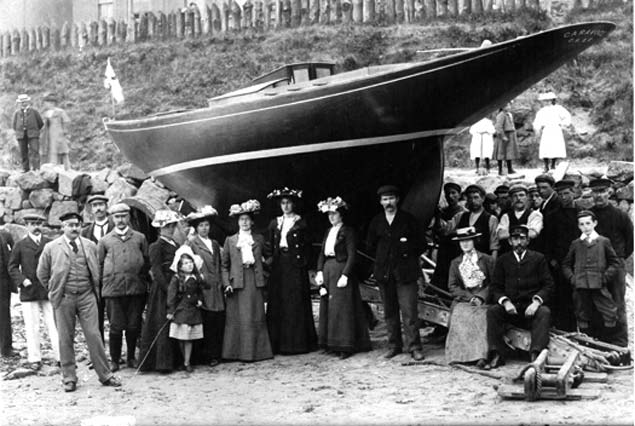 The launching of the new James Kelly-built Dublin Bay 21 Garavogue at Portrush in 1903. The original owner was W R Richardson. Photo courtesy Robin Ruddock
The launching of the new James Kelly-built Dublin Bay 21 Garavogue at Portrush in 1903. The original owner was W R Richardson. Photo courtesy Robin Ruddock
Sailing was one of them, and during the 1930s, The Lord owned and regularly raced the Dublin Bay 21 Garavogue, originally built by James Kelly of Portrush in 1903. She was well worn by the 1930s, thus it was Lord Glenavy who – at a Committee Meeting of the Royal Alfred Yacht Club in 1934 – first suggested the formation of a new, larger Bermuda-rigged One-design class for Dublin Bay.
This in time became the Dublin Bay 24s. But as the interruptions of World War II meant they didn’t have their first race until 1947, by this time Glenavy was getting near the end of his sailing career, and it concluded with the sale of Garavogue. Nevertheless, during his time with the boat, he and his family were very much involved with the class, and in his later writing, Patrick Campbell recalled how, on the rare enough occasions when Garavogue did very well, his father would exasperatingly delay going ashore after racing in order to take time out to mark all sheets with bits of brightly-coloured wool to show exactly how the sails had been trimmed when the boat was winning.
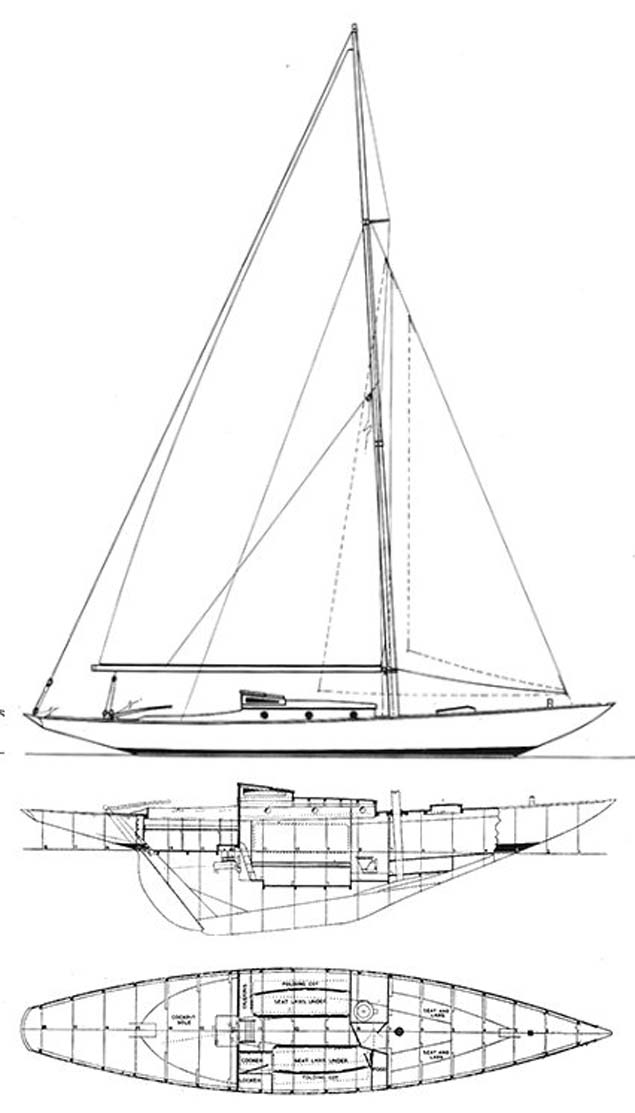 Plans for the Dublin Bay 24. The concept for a new class was originally suggested by Lord Glenavy at a Committee Meeting of the Royal Alfred YC in Dun Laoghaire in 1934, but by the time these plans were finally agreed and construction had started, World War II was looming, and the class was not to race in Dublin Bay until 1947.
Plans for the Dublin Bay 24. The concept for a new class was originally suggested by Lord Glenavy at a Committee Meeting of the Royal Alfred YC in Dun Laoghaire in 1934, but by the time these plans were finally agreed and construction had started, World War II was looming, and the class was not to race in Dublin Bay until 1947.
Needless to say, despite meticulously replicating the sail trim next time out, Garavogue would disappointingly fail to perform. But the boat and the class provided a source of anecdotes for Patrick Campbell’s subsequent humorous writing, with the annual Wicklow Regatta in particular providing a rich seam of narrative.
Long after he’d left Ireland to work first in England and then base himself happily with his third wife in the south of France while still continuing to produce gems of style and wit, he heard from Dublin Bay 21 enthusiast Fionan de Barra that Garavogue was still very much in existence, and wrote back with a contribution for a book (which will appear in due course) on the Dublin Bay 21s, and telling of his pleasure of learning of the boat’s continuing life, as he had long since assumed she’d become “a sturdy hen-house”.
 Rather more than “a sturdy hen-house”. The exquisitely-restored hull interior of Garavogue as seen in Kilrush Boatyard last September. Photo: W M Nixon
Rather more than “a sturdy hen-house”. The exquisitely-restored hull interior of Garavogue as seen in Kilrush Boatyard last September. Photo: W M Nixon
In later years, his career blossomed, for although he’d been educated in England, he never lost his Irish accent which was emphasized in television appearances (he was a star of panel and game shows), a pleasant accent which was emphasised by his sometimes total stammer, which he preferred to describe as “an attractive speech impediment”. He would emerge as cool as you please from ferocious bouts with it, while everyone around him had been reduced to acute nervous tension.
 Dublin Bay 21 sailor Patrick Campbell. He eventually found his metier as a “universal humorous writer” and a television performer, noted on screen for his relaxing Irish accent and a stammer which he preferred to think of as “an attractive speech impediment”
Dublin Bay 21 sailor Patrick Campbell. He eventually found his metier as a “universal humorous writer” and a television performer, noted on screen for his relaxing Irish accent and a stammer which he preferred to think of as “an attractive speech impediment”
In his extensive writings he wasn’t above a bit of Paddywhackery when writing about his erstwhile countrymen, which may partially explain who he is no longer as well-known here as he should be. But in mitigation, it should be said that the Paddy who was dealt the greatest whackery in his often wickedly funny writing was Paddy Campbell himself.
And ultimately he was Everyman, faced with the problems of being an accident-prone giant struggling to get through life with a modicum of dignity and subsequent humour. Thus although this piece – A Stallion Sneeze - about the hazards of extreme sneezing from the early 1960s begins with a reference to King’s Road in Chelsea at a time when Swinging London was coming to life, it was written in France, it is universal in its relevance, and it is very timely for our current situation.
A STALLION SNEEZE
I had written:
‘At eight o’clock on a Sunday morning King’s Road in Chelsea is a desolate waste of litter – old newspapers, ice cream cartons, torn shopping bags, cigarette ends by the million -’
Then I got this tremendous sneeze.
It was one of those sneezes the preliminaries of which seem to go on for ever. At one minute I was sitting there writing about litter in Chelsea and the next I was in the grip of a cosmic force so powerful that without straining itself in any way it began to change my whole physical shape. I began to feel like putty being moulded by a huge glazier.
First, this giant force got to work upon my jaws and mouth, pressing out and hardening this delicate machinery until, with the teeth bared and the upper lip drawn back, I must have looked like Silver, the mad white stallion, about to do something unpleasant.
At the same time this frightful pressure squeezed my eyes shut and then shoved them along the Eustachian tubes into my ears, where they flung themselves against the drums, trying to get out.
This displacement of the eyes led almost immediately to a change in the shape of the top of my head. It began to rise into a point, with the subsidiary effect of drawing me right up into the top left-hand corner of my high-backed chair, so that it seemed that I retained a grip upon the floor only with a single toe.
For some time I held this pose, levitating, teeth bared, lips curled, nostrils flaring, ears gone, eyes bursting and nails dug deep into the upholstery. Then everything blew up.
The actual explosion was preceded by a wild cry of mindless terror – a long drawn out yell sounding something like ‘AAAAAAGH’ – and then it burst.
I was surprised by the damage, except of course that the circumstances were rather special.
Just before I’d written the words about the litter in King’s Road I’d slipped half a large tomato, peppered and salted, into my mouth, where it joined a partially chumbled biscotte – one of those roasted bread slices which the French do so well. Into this mixture I then injected a mouthful – or as much of a mouthful as possible – of black coffee.
It was a tight fit but it would have been a viable proposition if it hadn’t been for the sneeze.
The whole business – typing with the mouth bursting with breakfast – came from being suddenly seized with an idea, after being dazzled for too long by the glare of an empty page. I felt I needed this last mouthful of breakfast, to sustain me, while at the same time rattling out the first sentence, before it got away.
Anyway, it burst.
For a moment I thought I’d blown the front of my face off. There was this awful feeling of everything coming away. I almost got my handkerchief to the site of the explosion and then there came another one, louder, wilder, infinitely more destructive than the first.
I lay back in my chair, spent, drained of everything, waiting for the third eruption – the one which would deprive me of my backbone, shooting it out through my nose in a spray of tinkling vertebrae which would probably smash the window on the other side of the room.
It turned out that we’d finished. These two major explosions, one even bigger than the other, were to be our portion for the day.
But at what a cost.
The extremely high muzzle velocity of the breakfast had enabled it to reach and to penetrate every corner and crevice of the room. It had got to the bookshelf and the Modigliani reproduction above it. It was on the door, the ceiling and all four walls. It was in the typewriter. It had even struck a portrait of me painted by an aunt of mine in 1954, where it had obliterated one eye. The other one stared at me in outrage.
I sat there, huddled in my chair, tomatoed, thinking what bad luck it all was. I was thinking that if Tolstoy had got one of those we wouldn’t have had War and Peace. A couple of those for Dickens would have meant curtains for both Dombey and his son.
I set to to clean up, sorry for the world that now would never hear about the surprising amount of litter in King’s Road at eight o’clock on a Sunday morning.
 The Dublin Bay 21 Class racing, with Naneen – now restored for Hal Sisk and Fionan de Barra – in the foreground. On the rare enough occasions when the Campbell family’s Garavogue did well, Lord Glenavy would keep everyone waiting while he used brightly-coloured wool to mark the exact setting of each sheet. Despite his efforts, almost invariably the excellent performance would not be repeated on the next outing, even with the sheets being trimmed precisely as they’d been when success was achieved
The Dublin Bay 21 Class racing, with Naneen – now restored for Hal Sisk and Fionan de Barra – in the foreground. On the rare enough occasions when the Campbell family’s Garavogue did well, Lord Glenavy would keep everyone waiting while he used brightly-coloured wool to mark the exact setting of each sheet. Despite his efforts, almost invariably the excellent performance would not be repeated on the next outing, even with the sheets being trimmed precisely as they’d been when success was achieved
Restored Dublin Bay 21s Will Start DBSC Racing in April
There has been excellent progress on the revival of the Dublin Bay Sailing Club Twenty One project the world’s oldest intact on design keelboat class as they prepare for a new season racing again on Dublin Bay.
Chris Moore of Dublin Bay Sailing Club has confirmed the original DBSC class has been granted a racing start for 2020 Tuesday evening racing starting this April.
Initially, two twenty ones will race then three as the boat building project based in Kilrush on the Shannon Estuary completes the six-boat project.
The restored boats will be welcomed back to the bay in a special DBSC gun salute from committee boat Mac Lir at the start of the season.
Back to the Future
You can join the '21 project leaders Hal Sisk and Fionán de Barra for a sailing talk and a two-course dinner on Thursday the 13th of February in the RStGYC Dining Room in Dun Laoghaire. The talk, “Back to the Future, the Revival of the DBSC Twenty Ones—the World’s Oldest Cruiser Racer Class" will be a visual presentation on the revival plans.
Dublin Bay 21 'Naneen' is Drop Dead Gorgeous
“They are drop dead gorgeous.” Those words came to mind this week when, amongst the collection of many Emails, phone texts and post that arrive each week there was a photograph which nicely illustrated those words.
Stephen Morris sent me from Kilrush the photograph here of the first sailing of the Naneen, the Dublin Bay 21, that I last saw at Kilrush on the morning she was returned to the water after her restoration led by Stephen.
“Thought you might enjoy this,” he wrote and I responded: “Beautiful would be an understatement.”
My colleague, our wordsmith-of-sailing-record, WM Nixon, will tell the detailed story of this “first” sail in his Afloat blog this Saturday, so suffice for me to say that Hal Sisk and Fionán de Barra had a magical day after they traversed across an icy morning on Naneen’s deck on Monday to go sailing. When I saw the photos those words I quoted at the outset were so apt, from a maritime discussion of which I was part at Kilrush when Naneen was re-launched and which I’ve waited for the opportunity to Podcast, which has come with this first.
The granddaughter of James Clancy, who built the 21s - Ann Griffin takes up the story on the Podcast below.
Kilrush on the Shannon Estuary Shows the Way for Dun Laoghaire – Again
In 1828, when the recently re-named and still only semi-finished harbour of Kingstown on Dublin Bay staged its first regatta, it certainly gave an indication of the transformed place’s potential for waterborne sport. Yet it was not until 1831 that the first club – the Royal Irish YC in its earliest form – came into being. But on the south coast at Cork, the stately Water Club had been going about its manoeuvres since 1720, and was organising racing by 1765 and probably earlier while going on to become the Royal Cork YC in 1831. And on the west coast in Kerry and along the Shannon Estuary, recreational sailing was relatively well established – not least because it provided a useful cover for some profitable smuggling of low-volume high-value commodities from France, Spain and Portugal.
Be that as it may, by the 1820s regattas were being staged at what was then one of the main ports, the sheltered though tidal Shannonside creek at Kilrush on the south coast of Clare, and in 1828 Maurice “Hunting Cap” O’Connell – the uncle and effectively guardian in his youth of Daniel O’Connell of Derrynane, The Liberator - organised a Kilrush regatta which led to the formation of the Royal Western Yacht Club of Ireland.
The club thrived, and by 1838 it was the named club of at least two dozen yachts, some of them quite substantial, with 18 of them based in Kilrush while others were kept by their owners on moorings in the estuary beside their often quite stately homes, a classic case being the Knight of Glin with his 30-ton cutter Rinevella moored off Glin Castle on the south shore.
 The Shannon Estuary – 55 nautical miles of history-filled waterway
The Shannon Estuary – 55 nautical miles of history-filled waterway
Thus the sailing scene on the Atlantic seaboard was thriving while the Dublin Bay programme was still in its infancy. But the situation was totally and tragically changed with the Great Famine of 1845-47. Apart from the human scale of the disaster - which we still do not fully grasp, and probably never will – while it may be simplistic to say that the economy of Western Ireland was destroyed, basically that’s what happened. Despite this, much of life along the east coast went on as normal, and yachting in Kingstown underwent a phase of rapid development.
Retreating from the wasteland which the West had become, what was left of the Royal Western Yacht Club of Ireland became an itinerant organisation, based for a while in Dublin city and then in Dun Laoghaire and finally in Cork Harbour, where it was supposedly wound up in Cobh in 1870. But it so happened that back in Kilrush the Glynn family had retained some artefacts, documents and records of the old club, other memorabilia was gradually traced and brought home over the years, for there were those who felt that the old Royal Western YC of Ireland had never really died, it was only sleeping, and all it needed was some miraculous revival of the port of Kilrush to waken it up.
Kilrush did slowly revive as a port after the famine, but it was for the utilitarian purposes of handling cargo in the dock, while a pier nearby at Cappagh served the needs of the Shannon ferry steamers which were such a feature of the estuary before rail and then road took over. After that, the port became a ghost of its former self, but there were those who could see its potential.
And the miracle came in 1990, when Brendan Travers of Shannon Development spearheaded the project to provide a barrier with a sea lock to make Kilrush into a proper marina. Today, it has facilities which put the allegedly pace-setting East Coast ports to shame, with the marina run by Simon McGibney while master-shipwright Steve Morris (who’s from New Zealand, but Irish women like his wife Michelle have a way of ensnaring useful talent and keeping it here) has been with the boatyard with its commodious sheds and workshops since 2001, where they seem capable of all forms of boat-work in any material, and to world class standards too.
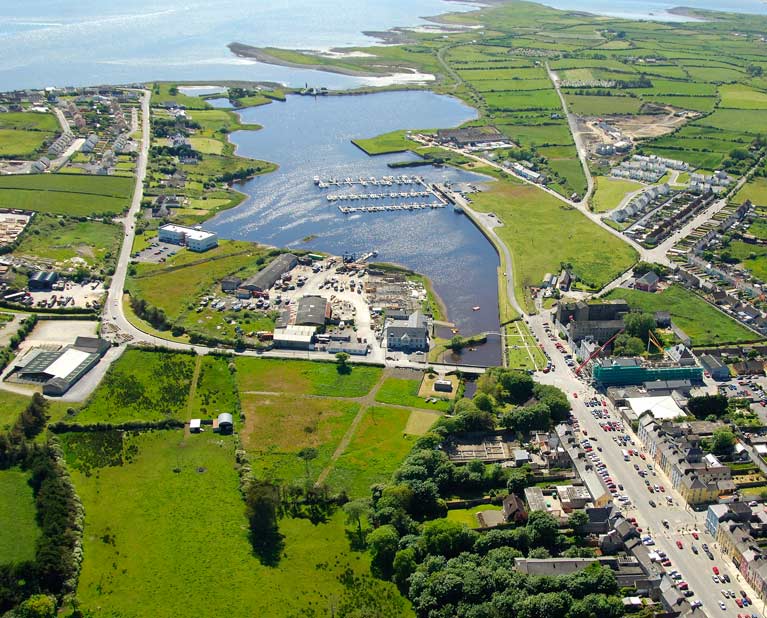 Kilrush today, with the extensive boatyard (centre) providing facilities that most other Irish sailing harbours can only dream of
Kilrush today, with the extensive boatyard (centre) providing facilities that most other Irish sailing harbours can only dream of
With this setup developing, the Royal Western Yacht Club of Ireland re-emerged as the club at Kilrush with a healthy marina-based fleet. In the early summer of 2007, a bundle of energy from Limerick called Ger O’Rourke contacted the Royal Ocean Racing Club to enter his Cookson 50 Chieftain for the up-coming Rolex Fastnet race in August. He was told he’d be 46th on the waiting list, but not to worry - many early entries tended to drop out, and with bad weather forecast, he was in with a good chance of a place.
O’Rourke had just completed a Transatlantic race from Newport to Hamburg to take second place, but he had this weird superstition of never entering his boat for the next big race until the previous one had been completed. Once again it came good - on the Tuesday before the Fastnet was due to start on the Saturday, the RORC told him it was all systems go, the place was there, so he rushed his crew together, they sailed a magnificent heavy weather race, and Chieftain became the overall winner of the 2007 Rolex Fastnet Race, making the Royal Western of Ireland and Kilrush the only Irish club and port which can claim this rare distinction.
 Ger O’Rourke’s Cookson 50 Chieftain from Kilrush shortly after the start of the Rolex Fastnet Race 2007, which she won overall – the first and still the only Irish boat to do so. Photo: Rolex
Ger O’Rourke’s Cookson 50 Chieftain from Kilrush shortly after the start of the Rolex Fastnet Race 2007, which she won overall – the first and still the only Irish boat to do so. Photo: Rolex
All of which is a roundabout way of saying that when the most varied group of people in Irish sailing that you’ve ever seen converged on Kilrush in Tuesday’s incredibly bright and uninterrupted sunshine for the launching of the first of the re-born Dublin Bay 21s which are being brought back to life for Hal Sisk and Fionan de Barra by Steve Morris and the equally talented Dan Mill and their team (which includes Kilrush’s own James Madigan of Ilen fame), we weren’t making a patronizing visit to encourage a new place on its way.
 The Naneen Restoration Team included (left to right) Steve Morris, James Madigan, Hal Sisk, Fionan de Barrra, Fintan Ryan and Dan Mill. Photo: W M Nixon
The Naneen Restoration Team included (left to right) Steve Morris, James Madigan, Hal Sisk, Fionan de Barrra, Fintan Ryan and Dan Mill. Photo: W M Nixon
On the contrary, it was more like a pilgrimage to a special place that was outdone in historic sailing style only by Cork Harbour, for in Dublin Bay organised sailing was just getting going when Kilrush was thriving, and Belfast Lough was likewise barely started. But back in the 1820s when life lacked many of today’s mostly superfluous distractions, sailing was big in the west – think Sligo too - and Kilrush and the Shannon Estuary were in the forefront of its energetic development, typified by the Knight of Glin who took his cutter Rinevella to Galway in 1834 for a big regatta, and won western sailing’s equivalent of the Galway Plate.
However, from 1850 onwards there’s no doubting Dublin Bay was a global pace-setter in sailing development, and the establishment of Dublin Bay Sailing Club in 1884 provided an organisation which very quickly was co-ordinating all the sailing of the three major Kingstown yacht clubs, establishing new classes of increasing boat sizes such that by 1898 it was the DBSC’s imprimatur which brought the famous Fife-designed Dublin Bay 25ft ODs into being.
All these numbers refer to the waterline length, which means the 25s were generously-canvassed 37-footers, the jet-set of Dublin Bay One-Design racing. So much so, in fact, that very soon there was a growing movement for something similar in style but in a smaller and more economically-manageable size. William Fife was busy with America’s Cup yachts for Thomas Lipton and other large projects for super-rich clients, so they turned to Scotland’s new rising star in the yacht design firmament, Alfred Mylne, who had already created a useful 20ft waterline design for Belfast Lough sailors, the Star class, which set a simple gunter sloop rig.
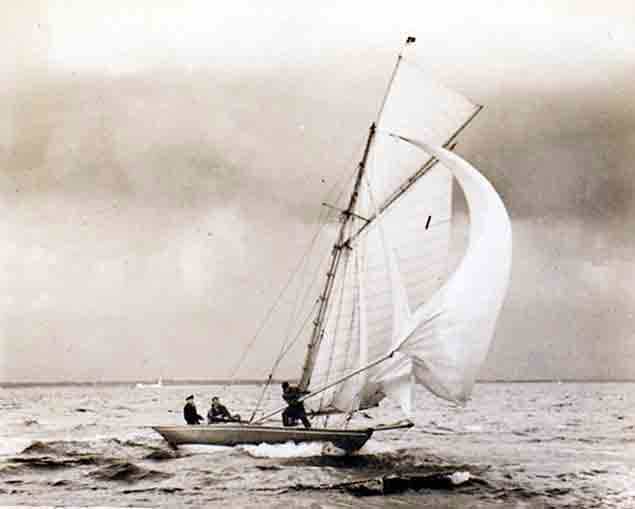 Simplicity was not the keynote in the original rig of the new Dublin Bay 21s in 1903 – in fact, for the first 60 years of their existence, they were defined by this challenging jackyard topsail-setting gaff cutter rig.
Simplicity was not the keynote in the original rig of the new Dublin Bay 21s in 1903 – in fact, for the first 60 years of their existence, they were defined by this challenging jackyard topsail-setting gaff cutter rig.
But simplicity was not the keynote for the new Dublin Bay 21. Slightly larger, she had a longer and more elegant stem than the Star’s rather snubbed bow, and instead of a straightforward hyper-economical gunter mainsail with just one headsail, she set acres of gaff rig with a jackyard topsail and was cutter-rigged with it – four sails by comparison with the Star’s two, and that’s before you add the spinnaker.
The first three boats were building with Hollwey of Ringsend in the winter of 1902-03, as the established Kingstown builders James Clancy and J E Doyle were busy with other works, notably yet more DB 25s. The bigger class had received a shot in the arm with a new boat ordered for the 1903 season for the Viceroy, Lord Dudley, to be built by Doyle. This meant that when the first five DB 21s raced in 1903 (two more having been built by James Kelly of Portrush), their advent was somewhat overshadowed by all the razzmatazz attached to the Viceroy racing in his new DB25 Fodhla.
 Garavogue on her launching day at Portrush in 1903
Garavogue on her launching day at Portrush in 1903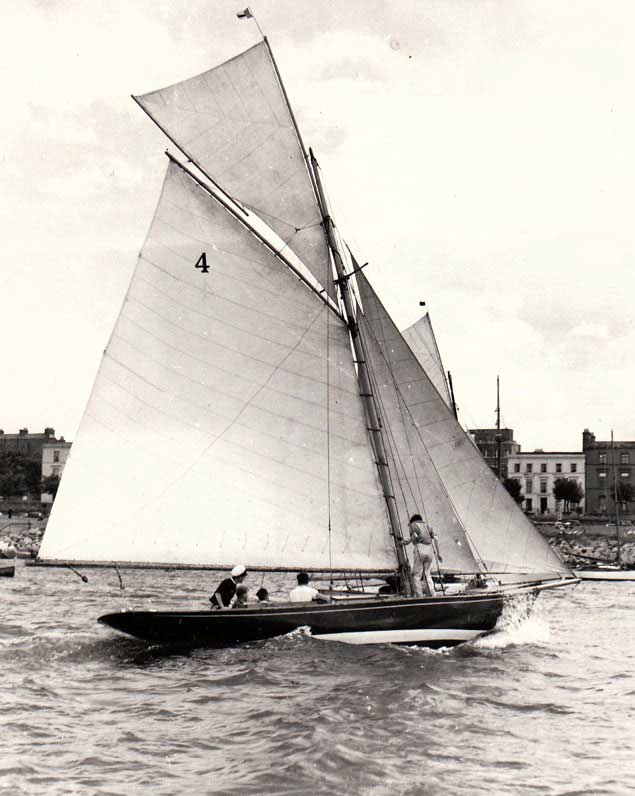 Garavogue in action in Dun Laoghaire Harbour. Her replacement hull has been built by The Elephant Boatyard in England, and is now in Kilrush for completion
Garavogue in action in Dun Laoghaire Harbour. Her replacement hull has been built by The Elephant Boatyard in England, and is now in Kilrush for completion
But the smaller class’s quality was soon recognized, and by 1908 they’d achieved their optimum number of The Sacred Seven with Geraldine being built by Hollwey, while Naneen – no 6 – had emerged as the only Kingstown-built boat. She was the work of James Clancy in 1905, built for a serial racing yacht owner called T Cosby Burrowes from Cavan. He must have owned a substantial part of that most rural of Irish counties, for it was presumably rental income which enabled him to be a member of eleven yacht clubs in Ireland, Scotland and England while buying new boats on a fairly regular basis. But though he raced in many places, Dublin Bay was his spiritual sailing home, and he’d served as DBSC Vice Commodore in 1900-1901.
The Ireland of people like Cosby Burrowes was to change inexorably through the 20th Century, yet the Dublin Bay 21s steadily continued to give great sport with such consistency that, despite being just seven in number, the regularity of their turnouts and the spectacular nature of their appearance became the best-known feature of Dublin Bay sailing.
But by the early 1960s the advent of series-production built fibreglass boats with alloy masts and synthetic sails was making their continued existence problematic, and in 1963 they persuaded veteran designer John Kearney (he was 83 at the time) to provide them with a new masthead Bermudan rig of 400 square feet as opposed to the original gaff’s 600, and they also requested a new coachroof with a doghouse to provide standing headroom.
 The new masthead Bermudan rig as fitted in 1963 enabled exceptional loading to be applied by the standing backstay, while the unsightly new doghouse distracted attention from the elegance of the sheerline.
The new masthead Bermudan rig as fitted in 1963 enabled exceptional loading to be applied by the standing backstay, while the unsightly new doghouse distracted attention from the elegance of the sheerline.
John Kearney was up to his tonsils at the time designing and over-seeing the building of the 54ft yawl Helen of Howth for Perry Greer, but his age of 83 notwithstanding, he took on this extra task and the simple rig he created balanced very well. It gave good performance while needing a smaller crew, but veterans of that Dublin Bay 21 era who were in Kilrush on Tuesday were mixed in their approval.
Paddy Boyd raced on his father’s Oola as a schoolkid, and he could well remember the magic moment when the vital but inadequate bilge pump – his special job - was replaced by a luxurious new Whale Gusher 25. Anyway, he is in no doubt that the new rig gave the class a further 22 years of useful life. But Fionan de Barra, the Keeper of the Flame who has kept The Sacred Seven intact as a group ever since they stopped sailing, and his project partner Hal Sisk, are of the opinion that the new masthead rig with its standing backstay – often tensioned with a wheel - meant that the mast was being pushed down into the hull in a destructive way that hadn’t been possible with the original gaff rig with its running backstays.
 DB21 veteran Paddy Boyd with Naneen in Kilrush. Racing regularly as a schoolboy aboard the family’s Oola, his happiest memory is of the day his father finally acquired a bilge pump which was man enough for the job. Photo: W M Nixon
DB21 veteran Paddy Boyd with Naneen in Kilrush. Racing regularly as a schoolboy aboard the family’s Oola, his happiest memory is of the day his father finally acquired a bilge pump which was man enough for the job. Photo: W M Nixon
Either way, the class was getting very tired by the mid-1980s. But any considered decision as to their future was decided by Hurricane Charlie in August 1986, with northeast gales of unbelievable ferocity sweeping into Dun Laoghaire to leave the Dublin Bay 21s either sunk or seriously damaged.
That was 1986. It is now 2019. But the sheer style of the DB 21s has never been forgotten. And as for what was left of the boats themselves, Fionan de Barra and friends managed to keep them intact as a group in various locations in County Wicklow, while one proposal after another was put forward for their revival.
 Naneen, the only DB21 to have actually been built in Dun Laoghaire, looking very sad in a Wicklow farmyard some years after the class had stopped sailing in 1986. Photo: Afloat.ie/David O’Brien
Naneen, the only DB21 to have actually been built in Dun Laoghaire, looking very sad in a Wicklow farmyard some years after the class had stopped sailing in 1986. Photo: Afloat.ie/David O’Brien
Naturally the yachting historian and classic yacht activist Hal Sisk was interested, but he had other projects in hand such as the restoration of the 1894 G L Watson 37ft cutter Peggy Bawn, a meticulous project finished in 2003 which has seen Peggy Bawn winning regattas and awards on both sides of the Atlantic.
But gradually he and Fionan started putting ideas together, and in a world which changes more rapidly than ever, they reckoned that a way of restoring the DB 21s as a class is to think of new ways of ownership and use. To do this they would have to use a rig simpler than the labour-intensive time-consuming jackyard tops’l setup of the originals, and a straightforward gunter sloop set up such as Alfred Mylne designed for a Scottish-built boat to the hull design – Zanettta in 1918 - seemed to fit the bill.
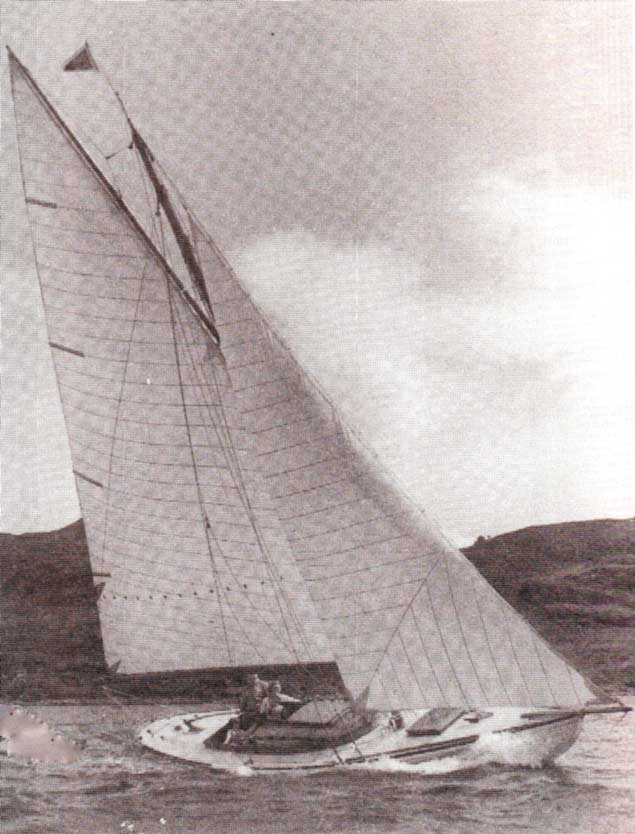 The easily-handled rig designed by Alfred Mylne for the Scottish-owned Zanetta of 1918 is the basic inspiration for the new rig on the class in Dublin Bay
The easily-handled rig designed by Alfred Mylne for the Scottish-owned Zanetta of 1918 is the basic inspiration for the new rig on the class in Dublin Bay
A traditional and historic local class such as the Howth 17s is one in which the people involved and their sense of community through the boat are every bit as important as the new boat itself, and thus the numbers of interested people are maintained over the years. But where a class has been sitting together but derelict and moth-balled for thirty years with the original owners and crews dying off and all ownership rights gradually accruing to one person – in this case Fionan de Barra – much radical thinking is needed.
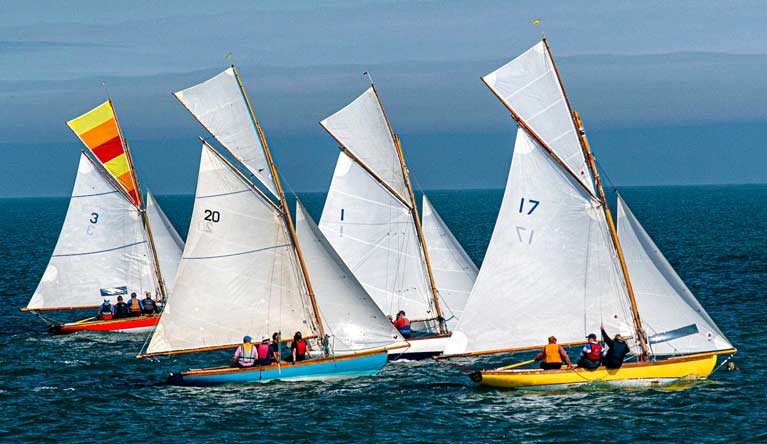 Howth Seventeens in action in their time-honoured style. They have been functioning continuously as a racing class since 1898, and with 19 boats, have an established total crewing panel of around a hundred people for whom a Seventeen is the first choice if they wish to go sailing. But as the new-look Dublin Bay 21s will be starting from scratch with no basic crewing panel, a completely new approach to ownership and the running of the boats is being devised. Photo Stormyphotos/Tom Ryan
Howth Seventeens in action in their time-honoured style. They have been functioning continuously as a racing class since 1898, and with 19 boats, have an established total crewing panel of around a hundred people for whom a Seventeen is the first choice if they wish to go sailing. But as the new-look Dublin Bay 21s will be starting from scratch with no basic crewing panel, a completely new approach to ownership and the running of the boats is being devised. Photo Stormyphotos/Tom Ryan
Thus Hal and Fionan have come up with the idea that the restored Dublin Bay 21 class – with the hulls built-in modern wood-style using the WEST system – would be an association-owned class of boats in a Dun Laoghaire Harbour which is itself being re-imagined for its use as an amenity and recreational area. To this new-use classic harbour they would bring a group of classic boats which are maintained as a unit, and accessible to all for sailing and special racing events based on the harbour of which they were such a natural part for 83 years.
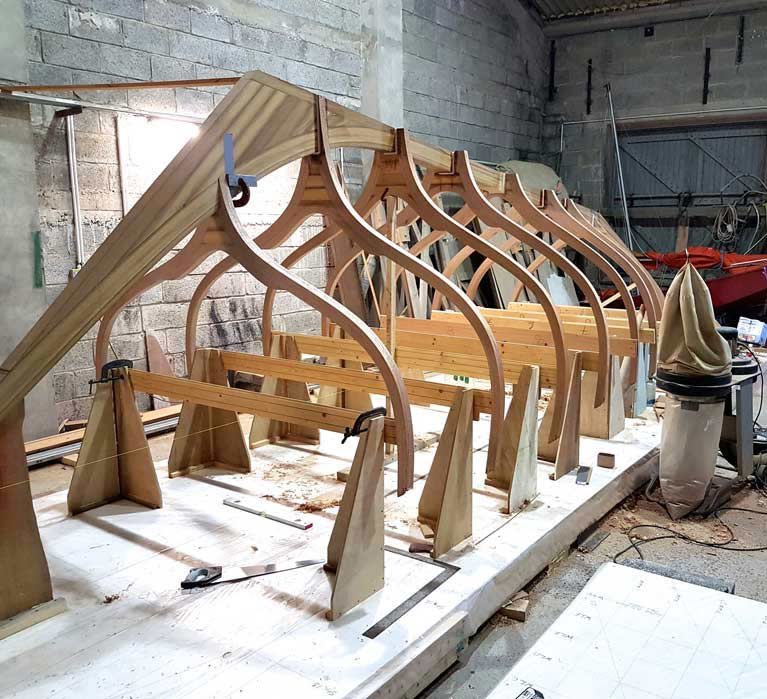 The “new” Naneen at an early stage of her re-build. Photo: Steve Morris
The “new” Naneen at an early stage of her re-build. Photo: Steve Morris
It’s an ambitious idea, but in this age of disappearing private ownership and shared use of vehicles ashore, with new business names like Borrow-a-Boat coming to the fore, it could well be that this re-born 116-year-old class is in the vanguard of how we will sail in the future.
Meanwhile, the boats have had to be re-built, and in Ireland they started with the only Dun Laoghaire-built boat, the Naneen of 1905 built by James Clancy, and took her to Steve Morris in Kilrush, while the Garavogue – built by James Kelly of Portrush in 1903 – went to classic boat specialists The Elephant Boatyard in the south of England.
Even with such skill involved in both England and Ireland, it has been a demanding task, but fortunately beforehand they could draw on the knowledge of design historian and classic specialist Theo Rye, and then after his sad and untimely death in 2016, the many talents of Paul Spooner took on the advisory role, and gradually the developing project began to take shape.
The casually interested might think it is all taking a remarkably long time, but so many novel concepts and new ways of thinking about boat use are evolving as each stage is passed that when the “new” DB21 class is complete, we’ll find that Hal Sisk and Fionan de Barra are true pioneers of sailing.
 A meeting of minds. Ilen skipper Paddy Barry (right) with Frank Larkin (left) and Steve Morris as the about-to-be-launched Naneen flies the DBSC burgee. Photo: W M Nixon
A meeting of minds. Ilen skipper Paddy Barry (right) with Frank Larkin (left) and Steve Morris as the about-to-be-launched Naneen flies the DBSC burgee. Photo: W M Nixon
Certainly the very supportive crowd which turned up in the Kilrush sunshine on Tuesday to wish them and the build team of Steve Morris and Dan Mill was representative of a very wide swathe of people seriously interested in classic boats and what you can do with them, such as Paddy Barry and Jarlath Cunnane fresh back from the restored Ilen’s voyage to Greenland, and James Madigan who was not only closely involved in re-building the Ilen in Limerick and Oldcourt and sailing to Greenland, but is from Kilrush and is now back home working with Steve and Dan on completing the Garavogue, whose hull has arrived in Kilrush from England.
There were several there who had sailed on the DB21s in the old days, in fact your columnist sailed in the Geraldine when she was still gaff-rigged in the ownership of Paul Johnson. But much more interesting were the views of Paddy Boyd, who has distant childhood memories of the old rig, and happy recollections of youthful exuberance under the new one.
In gazing at Naneen as she glowed in the sunshine with a sense of weightlessness in the boat hoist, he was moved to comment on how elegant the sheerline now looked under the original coachroof. John Kearney himself preferred neat low coachroofs - he thought doghouses were the invention of the devil - but the DB 21 owners of 1963 demanded it, and the result was a boxy shape which somehow disguised the fact that the original sheerline was well nigh perfect.
Certainly it was well-appreciated by Ian Malcolm of Howth, who was there on behalf of the Howth 17s but with a special interest, for after Storm Emma wreaked havoc on the Howth Seventeen fleet in their pier-end storage shed in March 2018, it was boat no 6, Anita built by James Clancy in 1900, which was the only total loss. Thus it fell to Ian, with his French connections, to arrange her re-build by Paul Roberts’ Les Atelier d’Enfer organisation in Douarnenez under the French government’s subsidized boat-building schools programme.
 People who re-build James Clancy boats with James Clancy people are left to right) Ian Malcolm who arranged the French re-build of Howth 17 No 6 Anita, built by James Clancy in 1900, with Ann Clancy Griffin, James Clancy’s grand-daughter who lives in Kilrush, James Clancy’s great-grand-daughter Sinead Griffin (also of Kilrush), and Hal Sisk, who has been central to the re-build of Naneen, DB 21 No 6, built by James Clancy in 1905. Photo: W M Nixon
People who re-build James Clancy boats with James Clancy people are left to right) Ian Malcolm who arranged the French re-build of Howth 17 No 6 Anita, built by James Clancy in 1900, with Ann Clancy Griffin, James Clancy’s grand-daughter who lives in Kilrush, James Clancy’s great-grand-daughter Sinead Griffin (also of Kilrush), and Hal Sisk, who has been central to the re-build of Naneen, DB 21 No 6, built by James Clancy in 1905. Photo: W M Nixon
This meant that in Kilrush on Tuesday we’d two sets of people who have been closely involved in the re-building of a Clancy of Dun Laoghaire boat during the past two years, but the coincidences didn’t stop there, as James Clancy married a Kilrush woman, and the family now has many connection in the town, with his grand-daughter Ann Clancy Griffin with her daughter Sinead Griffin doing the launching honours after Father Anthony Keane – who was Brother Anthony Keane of Glenstal Abbey before he went up to Greenland on Ilen – had made a quietly elegant ceremony out of blessing the boat.
 When he sailed to Greenland in the Ilen in July, he was Brother Anthony of Glenstal Abbey, but now he is Father Anthony Keane, and in his new capacity, he blessed Naneen before her launching on Tuesday. Photo: W M Nixon
When he sailed to Greenland in the Ilen in July, he was Brother Anthony of Glenstal Abbey, but now he is Father Anthony Keane, and in his new capacity, he blessed Naneen before her launching on Tuesday. Photo: W M Nixon
And then Naneen was launched. Simply by watching her being lowered gently we were given ample opportunity to admire the way in which Alfred Myne has harmonised the lines, such that every sweet curve complements all the other, with the little cabin, in particular, being a masterpiece. On the original drawings Mylne light-heartedly named its interior as “The Den”, but the 21s proved such good seaboats that one of the original owners, Herbert Wright who later went on to be founding Commodore of the Irish Cruising Club in 1929, took his new DB21 Estelle to Scotland on a cruise which worked out so well he wrote it up for Yachting Monthly magazine, which prompted Hal Sisk to claim that the Dublin Bay 21s were thus the world’s first genuine cruiser-racer class.
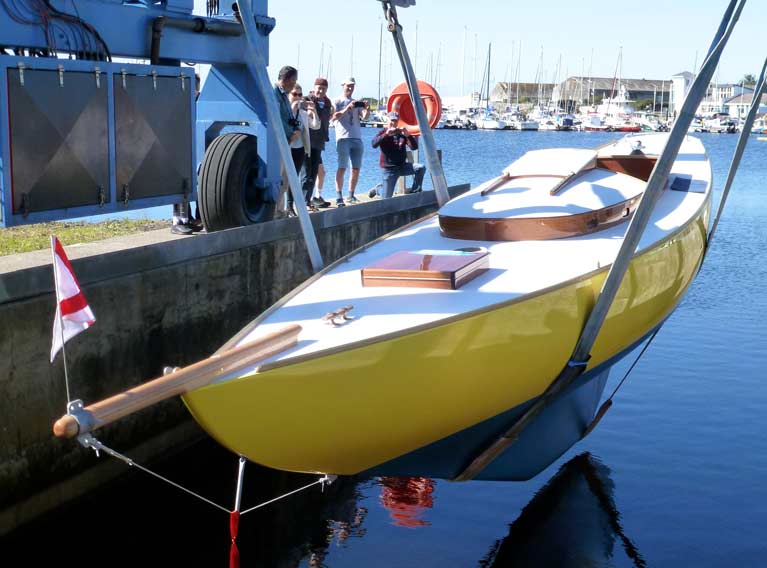 The harmony of Naneen’s pure lines as drawn by Alfred Mylne became even more evident as she was lowered gently into Kilrush Creek. Photo: W M Nixon
The harmony of Naneen’s pure lines as drawn by Alfred Mylne became even more evident as she was lowered gently into Kilrush Creek. Photo: W M Nixon
 Is she not very lovely? That Alfred Mylne, he certainly had an eye for a boat….. Photo: W M Nixon
Is she not very lovely? That Alfred Mylne, he certainly had an eye for a boat….. Photo: W M Nixon
Clearly there’s a quality to their size and the way they feel when you step aboard which seems just right, and suggests uses more ambitious than simply racing in Dublin Bay, though heaven knows the pace of their racing was scarcely simple, for it was hectic and furiously – sometimes genuinely furiously – competitive.
But all would be well at the end of the day, and with the new creation afloat, Fionan ushered us back to the boat-building shed for the perfect boat-launching lunch, a simple yet effective and nourishing boat-oriented meal provided by Noel Ryan of Ryan’s Butchers & Deli in the town. It was an extension of the opportunity to meet the huge diversity of people who had come to wish this extraordinary project well, a glimpse of the area’s diversity for there was time to talk with Frank Larkin of Limerick, whom I first met through sailing. Then when he became Corporate Communications Manager for Shannon Development, he used to recruit me to give slide shows to Limerick’s sailing fraternity, and the next day we’d go to Foynes or Kilrush to see the developing local setup, all extremely educational for this was in the days before Kilrush had its barrier and Foynes had yet to have its largely voluntarily-installed marina.
 The perfect post-launch boatyard lunch gets underway beside a new traditional gleoiteog which is another high-standard project the yard has underway at the moment. Photo: W M Nixon
The perfect post-launch boatyard lunch gets underway beside a new traditional gleoiteog which is another high-standard project the yard has underway at the moment. Photo: W M Nixon
There too was Kim Roberts who has run a boatyard in her time, and then driven an enormous crane for big contracts on the south shore, and has since been manager of Kilrush marina but is now running Vandeleur antiques from The Old Forge in Killimer and sailing a restored classic timber Drascombe which, as we saw last week, she has taken about as far up the Shannon as it is possible to get from Kilrush.
From up the Shannon was David Beattie of Lough Ree, whose steel version of Slocum’s Spray may have originated in the Lough Ree area, but now under David’s command she has cruised extensively in the Med before returning recently to Ireland for work to be done at the Ryan & Roberts boatyard at Askeaton on the Shannon Estuary’s south shore. And equally appreciative of the Naneen restoration was that legendary shipwright sailor Albert Foley, who’s on the mend after a recent illness, and plans to get his Swan 36 – which he re-built after everyone else considered her a write-off after she’d been run down by a survey vessel – back sailing again.
Then came the moment of truth - the post-lunch revisit to the floating Naneen to see how things were. The sheer pleasure of being aboard a pristine wooden boat in the sunshine with new varnishwork and a slight hint of linseed oil and all the aromas of a healthy environment in The Den were followed by that important ceremony: The First Lifting of the Floorboards.
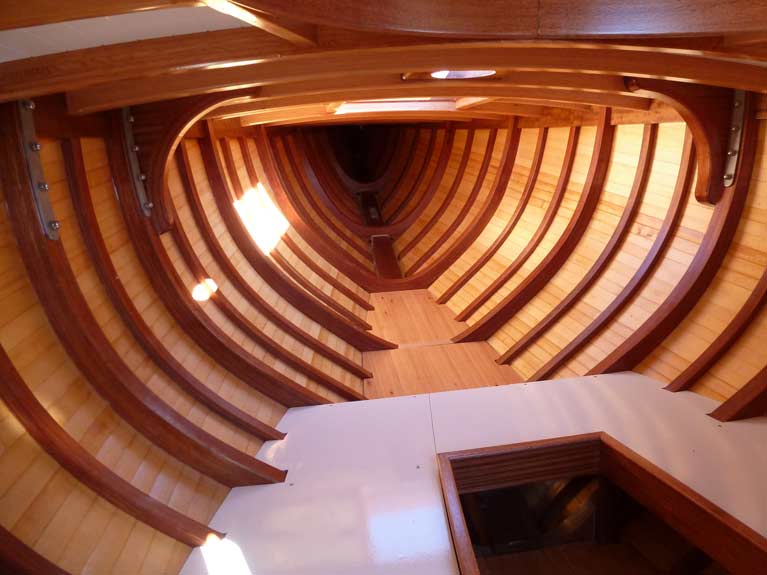 Super workmanship in evidence below on Naneen, looking forward from “The Den”. Photo: W M Nixon
Super workmanship in evidence below on Naneen, looking forward from “The Den”. Photo: W M Nixon
They’ll have a problem with Naneen. No arachnophobes will be able to sail aboard. The bilges fore and aft were bone dry. Inevitably some dust and other peculiar forms of nutrition and the occasional tiny insect will find their way in, and in time there will be a spider’s web or two. Definitely not a boat for arachnophobes……
 Exquisite workmanship hiding structural strength – the hanging knee fitted in Naneen to distribute the load from the internally-installed main shroud chainplate. Photo: W M Nixon
Exquisite workmanship hiding structural strength – the hanging knee fitted in Naneen to distribute the load from the internally-installed main shroud chainplate. Photo: W M Nixon
Before leaving Kilrush for the long haul home courtesy of Ian Malcolm with his high-and-very-mighty boat-towing vehicle, we had one further pleasant task – to pay our respects to Sally O’Keeffe in the marina. She is the handsome workmanlike 25ft cutter designed by the talented Myles Stapleton to a concept based on the Shannon Estuary hookers of all sizes which used to carry cargoes the length and breadth of the mighty waterway, and there was one in particular called Sally O’Keeffe which was based in Querrin to the west of Kilrush, where she’s part of folk memory.
A sort of Men’s Shed group in Querrin got together to build an interpretation of the Sally in the big barn at a local farm, Steve Morris came along and kept the work on track, and the result is one of the most attractive boats in all Ireland, a no-nonsense multi-purpose craft which has turned heads and won competitions at places as far apart as Glandore, the Baltimore Woodenboat Festival in West Cork, and Cruinniu na mBad in Kinvara on Galway Bay, making a point of sailing to these places along the Atlantic seaboard from Kilrush.
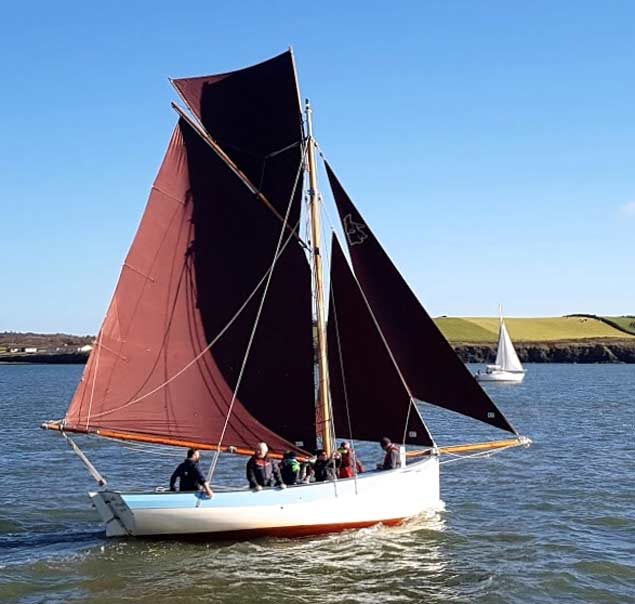 Sally O’Keeffe is the outcome of a very successful community venture in neighbourhood boat-building guided by Steve Morris.
Sally O’Keeffe is the outcome of a very successful community venture in neighbourhood boat-building guided by Steve Morris. Steve Morris – he seems to be able to turn his hand to any boat-building project with complete success. Photo: W M Nixon
Steve Morris – he seems to be able to turn his hand to any boat-building project with complete success. Photo: W M Nixon
She’s about as perfect as you can get in her way, yet she’s as different as possible from the equally perfect Naneen, and we’d the chance to compare them directly, for even as we were admiring Sally, the Naneen came into the berth just across the walkway.
All I can say is that when some project gets the Steve Morris touch, it becomes something very special indeed. We departed on a high, determined to make the best of that extraordinary day by enveloping the entire Shannon Estuary experience through heading homewards by way of the Killimer-Tarbert Ferry, and along the south shore we were able to look across to the islands at the mouth of the estuary of the Fergus River where the 1886 America’s Cup Challenger Galatea came to visit Paradise House (that’s really what it was called), the Shannonside ancestral home of owner William Henn.
Then we swept into Foynes to admire the crisp style of the thriving yacht club while gazing thoughtfully across to the cottage on Foynes Island where global circumnavigation pioneer Conor O’Brien of Saoirse fame spent his last years, and where the restored Ilen had come in the Autumn of last year to pay her respects, and then we went to see Cyril Ryan and the wide range of work he does at Ryan & Roberts at Askeaton, where he has a boatyard in classic style where we marvelled at the huge road crane Kim Roberts used to drive, and marvelled equally at the enormous tidal range in the River Deel, for David Beattie’s Ree Spray was a very long way down indeed in a muddy pool at the pontoon.
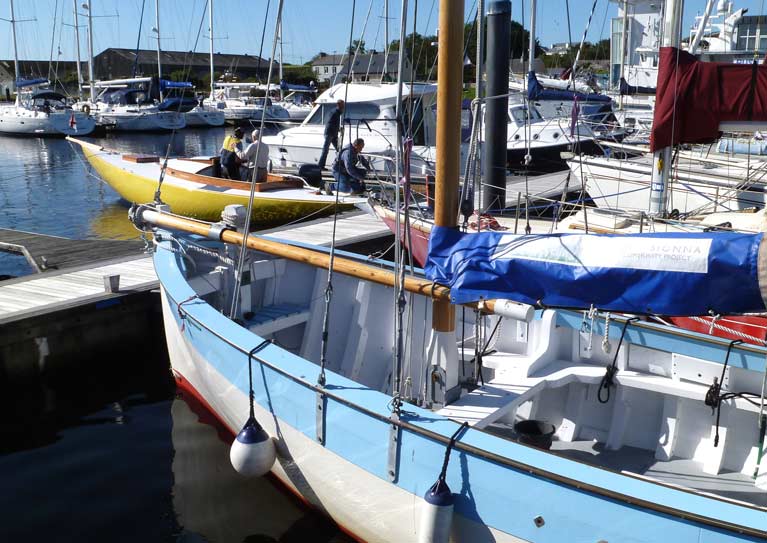 Product line…..the “new” Naneen (beyond) and Sally O’Keeffe (foreground) get together in Kilrush Marina at the end of an extraordinary day. Photo: W M Nixon
Product line…..the “new” Naneen (beyond) and Sally O’Keeffe (foreground) get together in Kilrush Marina at the end of an extraordinary day. Photo: W M Nixon
And finally, we went for a pit stop in the Dunraven Arms in Adare and wondered again at the sometimes misunderstood genius of the neighbourhood’s Lord Dunraven, with his two America’s Cup Challenges in 1893 and 1895. Then with a seemingly eternal sunset at our backs, we left Ireland and went back across the isthmus to Howth, simply stunned by the memory of the incredible range of the Shannon Estuary’s sailing history and its many links, a memory which had somehow given us a much clearer understanding of what it is that Hal Sisk and Fionan de Barra are trying to achieve with their pioneering vision for the future of the DB21 class.
 Naneen is coming home….Naneen, the only Dublin Bay 21 to be actually built in Dun Laoghaire, is the first one to be restored. She is seen here in the successful ownership of Terry Roche during the 1950s. Photo courtesy Olga Scully
Naneen is coming home….Naneen, the only Dublin Bay 21 to be actually built in Dun Laoghaire, is the first one to be restored. She is seen here in the successful ownership of Terry Roche during the 1950s. Photo courtesy Olga Scully
The Dublin Bay 21s: The World's Oldest Cruiser Racer Class
I won’t be challenging Hal Sisk’s confident declaration that he is Chairman of “the world’s oldest cruiser-racer class!”
His offer to anyone to challenge him sounded across Kilrush Boatyard to where I had driven over 400 kilometres from Cork to see a restored Dublin yacht, saved from rotting in a Wicklow farmyard, returned to the waters of Clare on the edge of the Shannon Estuary and which is bound, with others of the same maritime vintage, to be returned to the waters of Dublin Bay, by sail from Arklow after transportation thereto by road from the Banner county.
If all that seems a convoluted story, just add into the mix that it’s all to do with a major error by the same Class which caused controversy, division and dissension amongst its members because the rig of the same boats was changed. That was from gaff to Bermudan, which put too much strain and pressure on the craft, after which they had a sojourn in an Arklow boatyard that closed down, languished for 30 years in a Wicklow farmyard where they nearly rotted totally away, but from which they were recovered and transported to Kilrush for restoration. Next step is a return to an original rig that dates back to the last century, which will be accompanied by modern sails from Cork.
"Those of us present were part of an epoch-making day of Irish sailing history"
If you’re still keeping up with me, this is the story of rebreathing life into the Dublin Bay 21 Class where the canary yellow of Naneen seemed to even dominate the sunshine and the sparkling blue waters of Kilrush as she was launched after her restoration in front of a gathering of sailors from many parts of the country this week, assembled at the invitation of the said Hal Sisk whose request to be present to witness the occasion was not to be turned down. It was, in fact, a great day to be in the Kilrush yard. Those of us present were part of an epoch-making day of Irish sailing history, a day which was a tribute to those whose determination has brought back to life the 114-year-old Naneen and will result in the Class owning the restored Dublin Bay 21s.
 Fionan De Barra at the launch ceremony Photo: Afloat. Listen to the podcast below.
Fionan De Barra at the launch ceremony Photo: Afloat. Listen to the podcast below.
The best way to appreciate what has been done is to listen to my Podcast interview here with the Class Secretary, Fionán de Barra. I recorded so many interviews at Kilrush that they will make a special edition of my programme, THIS ISLAND NATION and my colleague, the estimable WM Nixon, tells me he will provide further elucidation about this project in his blog on Saturday here.
New Life for Dublin 21s as 'Naneen' is Unveiled in Kilrush
Once thought impossible due to the entire seven boat fleet rotting in a County Wicklow farmyard, the first revived Dublin Bay 21 'Naneen' was revealed yesterday at Kilrush Boatyard in County Clare.
The Hal Sisk led project has been working on the legendary Dublin Bay 21 class, the famous Mylne design of 1902-03, since late 2016.
The 21 was rebuilt by boatbuilder Steve Morris of Kilrush with assistance in later stages from Dan Mill.
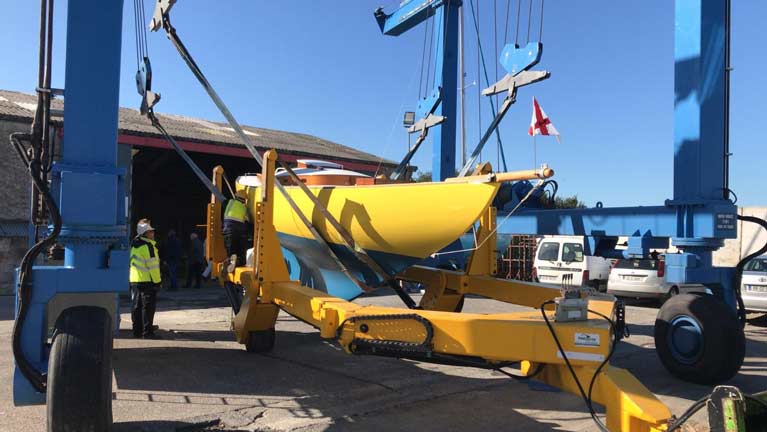 DB21 'Naneen' with the Dublin Bay Sailing Club burgee on her bow is prepared for launch
DB21 'Naneen' with the Dublin Bay Sailing Club burgee on her bow is prepared for launch
As Afloat reported previously, far from bringing the original and almost-mythical gaff cutter rig with jackyard topsail back to life above a traditionally-constructed hull, Sisk is content to have an attractive gunter-rigged sloop – “American gaff” some would call it – above a new laminated cold-moulded hull which was built inverted and fitted on the original ballast keels, thereby maintaining the boat’s continuity of existence, the presence of the true spirit of the ship.
The first DB 21 to get this treatment is Naneen, originally built in 1905 by Clancy of Dun Laoghaire for T. Cosby Burrowes, a serial boat owner from Cavan.
It’s a fascinating and complex project to which W M Nixon will be returning to in his blog this Saturday.
Dublin Bay 21 Revival & Ilen Restoration Get On-Site Consultation With Classics Designer Paul Spooner
The restoration of classic yachts and traditional craft to the recognised international standard is still relatively new in Ireland writes W M Nixon. In fact, it could be argued that the major project in Dunmore East, completed in 2005 on the 1894 G L Watson-designed 37ft cutter Peggy Bawn, is still the only example we have in Ireland of the painstaking and meticulous research and work of the highest quality that is required on a vessel of this size for total authenticity.
The Peggy Bawn project was for maritime historian Hal Sisk, and while Michael Kennedy was the lead shipwright, many specialist talents were involved in creating a widely-admired masterpiece.
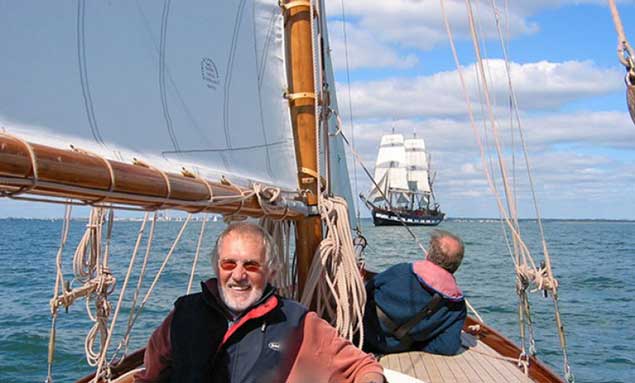 Hal Sisk aboard the restored 1894 Peggy Bawn in Dublin Bay in 2005. In the background is the Jeanie Johnston – in those days, she still sailed. Photo: W M Nixon
Hal Sisk aboard the restored 1894 Peggy Bawn in Dublin Bay in 2005. In the background is the Jeanie Johnston – in those days, she still sailed. Photo: W M Nixon
Now Hal Sisk is working on a completely different idea, a revival of the legendary Dublin Bay 21 class, the famous Mylne design of 1902-03. But in this case, far from bringing the original and almost-mythical gaff cutter rig with jackyard topsail back to life above a traditionally-constructed hull, he is content to have an attractive gunter-rigged sloop – “American gaff” some would call it – above a new laminated cold-moulded hull which is being built inverted but will, when finished and upright, be fitted on the original ballast keels, thereby maintaining the boat’s continuity of existence, the presence of the true spirit of the ship..
It’s a fascinating and complex project to which we’ll be returning in future postings on Afloat.ie. For now, the first DB 21 to get this treatment is Naneen, originally built in 1905 by Clancy of Dun Laoghaire for T. Cosby Burrowes, a serial boat owner from Cavan who had formerly owned Nance, the 1899 Dublin Bay 25 which was the only DB25 to be built by designer William Fife’s own yard in Fairlie – she still sails in the Mediterranean, now under the name of Iona.
As for Naneen, she was soon under new ownership as Burrowes interests turned elsewhere. She raced with the class in Dublin Bay under the original gaff rig until 1964, and then under the masthead Bermudan sloop rig, which kept these attractive boats going as an active racing class until August 1986.
In that fateful year, the after-effects of Hurricane Charlie in Dun Laoghaire Harbour resulted in their damaged hulls of the Dublin Bay 21s being retrieved and stored in a Wicklow farmyard while everyone worked out various schemes to make good use of this historic flotilla of seven very significant and attractive boats.
Hal Sisk and DB21 “Guardian” Fionan de Barra, after much research, have now developed this moulded hull/simpler rig philosophy which revives the class while retaining its character. And in Steve Morris at Kilrush in County Clare, they have a skilled boat-builder who has already shown with the Shannon cutter Sally O’Keeffe and other projects that he brings very special talents that work well in a wide variety of boat-building challenges.
 The proposed rig for the new-style Dublin Bay 21s will be a variation on this rig which Alfred Mylne designed for the DB21 sistership Zanetta, which was built in Scotland for a Clyde owner in 1918, but was used as a cruiser and never joined her sister-ships in Dublin Bay
The proposed rig for the new-style Dublin Bay 21s will be a variation on this rig which Alfred Mylne designed for the DB21 sistership Zanetta, which was built in Scotland for a Clyde owner in 1918, but was used as a cruiser and never joined her sister-ships in Dublin Bay
However, in order to maintain the integrity of the project, the actual design of the Dublin Bay 21 hull had to be agreed to very close limits, far removed from the free-and-easy approach of boat-builders in the early 1900s. For this, they have been able to draw on the highly-trained skills of designer and classics consultant Paul Spooner, who worked with Duncan Walker’s famous Fairlie Restorations company for twenty years, and has seen through some extremely demanding projects thanks to his fully-qualified status as a naval architect and engineer.
Using Paul Spooner’s drawings, the work in Kilrush has been proceeding steadily since late summer, and in recent days a stage had been reached where Paul Spooner’s presence was required on-site in order to finalise some key decisions. But he’s a very busy man, so to optimize his presence here, Hal Sisk linked-up with Gary MacMahon of the Ilen Project of Limerick and Baltimore, as the riggers developing the restored sail-plan of the 1926-built 56ft Conor O’Brien ketch Ilen had also been seeking Paul’s expert advice on their work.
While logistically challenging, it was all just possible in three recent days, and despite freezing damp weather in the west, Paul Spooner put in useful time in Kilrush where Steve Morris’s work is a joy to behold, and then he was transferred to the care of the Ilen team and whisked from Limerick to Baltimore.
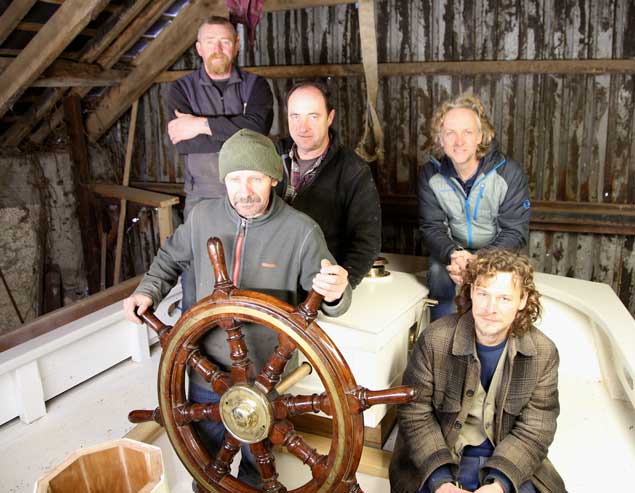 Paul Spooner (top right) with some of the Ilen team aboard the ship in Baltimore with the restored wheel steering system. With him are (top left) Jim McInerney and James Madigan (wooden boat builder), on wheel is Tony Daly (Shannon fisherman & wooden boatbuilder), while right foreground is Matt Dirr (“Builder of Curved Structures”). Photo: Gary MacMahon
Paul Spooner (top right) with some of the Ilen team aboard the ship in Baltimore with the restored wheel steering system. With him are (top left) Jim McInerney and James Madigan (wooden boat builder), on wheel is Tony Daly (Shannon fisherman & wooden boatbuilder), while right foreground is Matt Dirr (“Builder of Curved Structures”). Photo: Gary MacMahon
There, in The Old Corn Store in Oldcourt Boatyard where Ilen has been re-born, many assembled parts that we’ve seen recently on Afloat.ie being built in the Ilen Boat-Building School in Limerick has now been fitted in the ship, and here too the Paul Spooner presence brought reassurance that they were working in the right direction.
As for which direction Paul Spooner himself was going, it would have been overly-demanding for any lesser man. But having given advice of gold dust quality to two major restoration projects in Ireland, he then hopped on a plane in Dublin Airport and went to Japan, where he is being consulted on the restoration of a large 1927-vintage Camper & Nicholson ketch. That’s how it is at the leading edge of classic restoration projects.
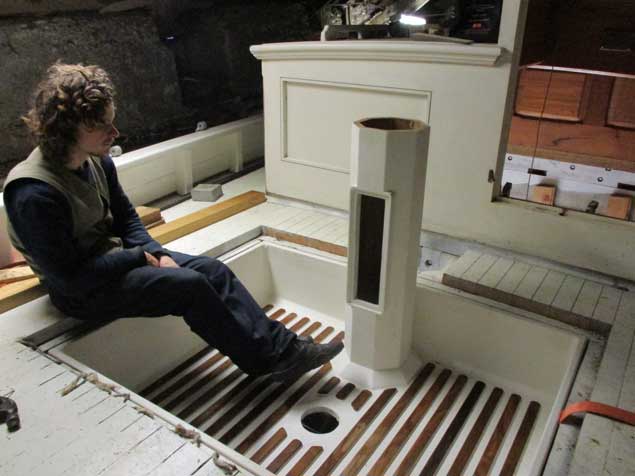 Dream on…..Ilen School’s Matt Dirr in thoughtful mood aboard Ilen after the new Limerick-built footwell has been installed on board in Baltimore. Photo: Gary MacMahon
Dream on…..Ilen School’s Matt Dirr in thoughtful mood aboard Ilen after the new Limerick-built footwell has been installed on board in Baltimore. Photo: Gary MacMahon






























